2012 VOLKSWAGEN GOLF PLUS child restraint
[x] Cancel search: child restraintPage 57 of 541
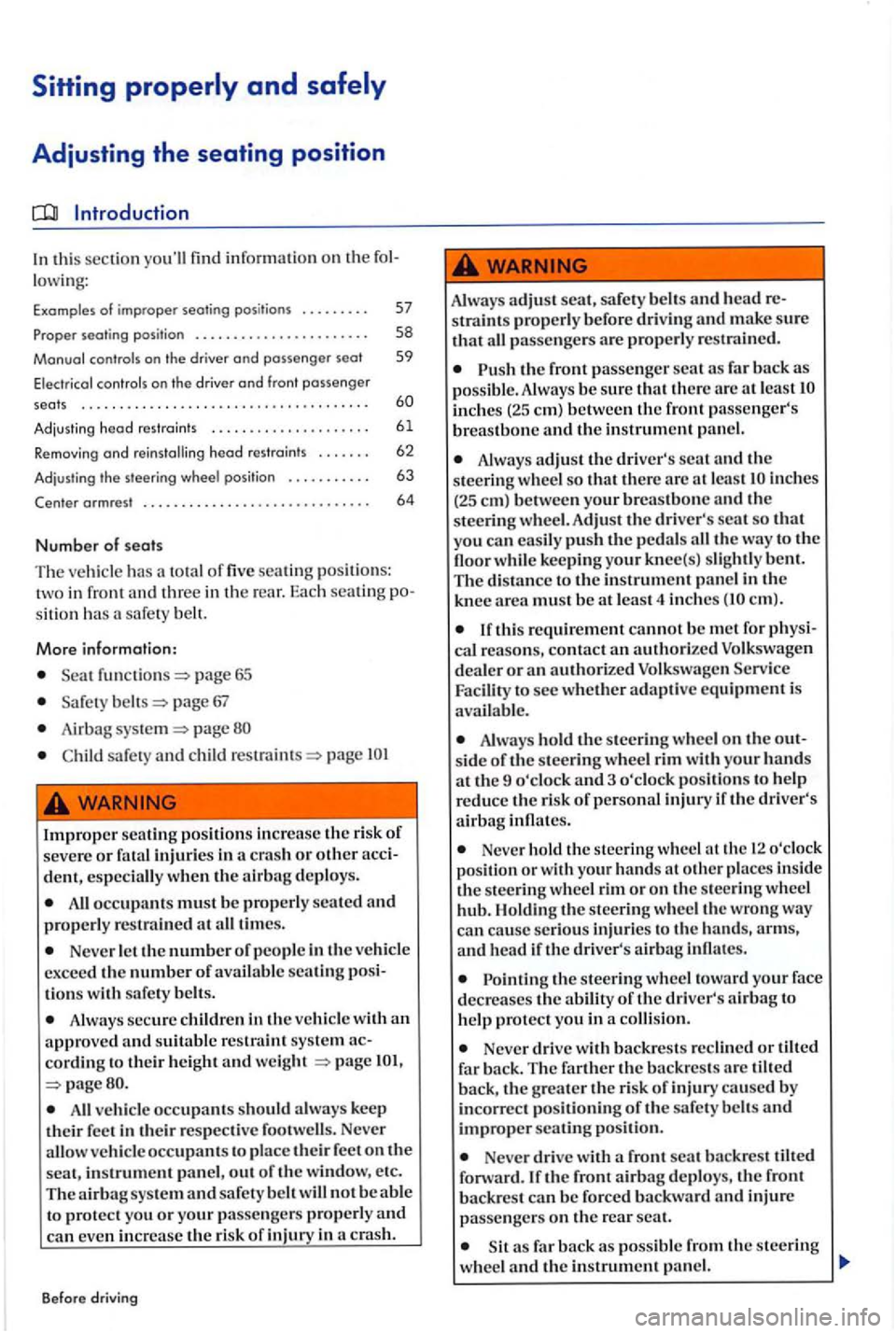
Sitting properly and safely
Adjusting the seating position
Introduction
In thi s sect io n you'll find information on th e lowing:
Examples of improper sealing positions . . . . . . . . . 57
Proper seating position . . . . . . . . . . . . . . . . . . . . . . . 58
Manual controls on the driv er and passenger
. . 62
Ad jus ting the s teeri ng wheel positio n . . . . . . . . . . . 63
Center a rmrest . . . . . . . . . . . . . . . . . . . . . . . . . . . . . 64
Number o f
Th e ve hicl e has total of five seating positio ns: in fron t and three in the re ar. Each sea tin g sition saf ety be ll.
More information:
pag e 65
page 67
Airbag page
sa fe ty and child page
Improper se atin g pos itions increase th e risk of severe or fata l injurie s in a cras h or other dent, especially w hen th e a irbag deploys.
All occupants mus t b e properly seate d and properly restra ined at all tim es.
Never lett h e number of people in the veh icle
excee d the number of availabl e seatin g tions with sa fe ty belt s.
Alw ays secure childr en in the ve hicl e with an approve d and suitable restraint system cord ing to t heir he igh t and weight
All vehi cle occupants shou ld alway s keep
th eir fee t in their r espective footwell s. Neve r
a llow veh icle occ upants to place their feet on the scat, in strume nt panel, out of th e w ind ow, etc. The and eve n in crease the risk of inju ry in a cras h.
B efore driving
Always adjust scat, sa fcry belts and head straints properly befo re drivin g and m ake sure that passe nge rs are prope rl y restrai ne d.
the front passenger sc at as
inch es (25 e m) between th e front passenge r's breastbone and the instrument panel.
Alway s adjus t the driver's scat and th e
s teeri ng wheel so that there arc at least
em).
or an authorized Volkswagen Facilit y to sec w hether adaptive equipment is availabl e.
Alwa ys hold the steerin g wheel on the side of th e steering wheel rim with your hand s at the 9 o'clock and 3 o'clock positi ons to help reduce the risk of p ersonal inju ry if th e dri ver's
a ir bag inflates.
Neve r hold the stee ring whee l at the 12 o'clo ck
po siti on or with your hand s at o th er places insid e
the stee ring wheel rim or o n th e stee rin g w hee l hub. the steering w heel the wrong way
ca n ca use serio us in juries to the hands, arms,
and h ea d if th e driver 's airbag inflates.
t h e s teeri ng whee l toward your face
d ec reases the abiliry of the driver's airbag to
h elp prot ect yo u in a co llisio n.
Never drive with backre sts reclin ed or tilt ed
far back . T he farther th e backr ests arc tilted back, the g reater th e r is k of injury caused by
in correc t positioning of th e safet y belt s and
improper seati ng position.
Never drive with a front seat backres t tilted
forward. If the front airbag deploy s, th e front
backres t ca n b e forced backward and injure
p asse ngers on th e rear scat.
far back as possibl e from the s tee ring
whee l a n d the in strument panel.
Page 68 of 541

Safety
Introduction
this sec tion y o u'll find informatio n on th e lowing:
Warning light ................ .... .. , .. .. , . . . 68
F ro ntal collis ions and l ows of ph ys ics . . . . . . . . . . . . 69
Whot happens to passengers no t wearing a safety
b elt? . . . . . . . . . . . . . . . . . . . . . . . . . . . . . . . . . . . . . . .
. . . . . . . . . .
. . 7 5
Safety belt exte nder . . . . . . . . . . . . . . . . . . . . . . . . . . 7 6
Safety belt retractor , pre te nsio ner, load limiter . . . . 78
Serv ice and d isposal of belt prete nsioners . . . . . . . 78
th e co nditi on of all safe ry belt s re gul arly. If a
sa fe ty belt s h ows da m age to we bbin g, b in din gs,
r et rac tors or bu ckles, have the safe ty belt replaced
b y an auth orized Volkswagen deafer or an rized Volk swagen Service rized Volkswagen deale rs and authorize d sw age n Se rv ice Fa cilities
Adju stin g th e seatin g pos ition
A ir ba g page
safety and c hild page
erl y position ed safety belt increa ses th e risk of severe pe rsona l injury or death. S afety belt s
offer optimum protection only whe n they are
u sed pro perly.
Safety belt s are the singl e most effecti ve
m eans availabl e to reduce th e r is k of seriou s jury and dea th in automobil e accid ents. For
your protection and that of your passengers ,
hicl e is moving.
Sitting properly and safely
Every person in the vehicle must b e properly
seat ed on
for e the vehicl e starts to move, and must k eep the belt properl y fastened while riding in the hicle. This applie s to the drive r and all g ers, ev en when ju st dri ving around town.
Alwa ys secure children in the vehicl e with a
restraint s ys te m appropriate for their age,
weight and page
Never attac h the safety belt to the buckl e o f another seat. Attachin g the safety belt to the wrong buckle will reduce safe ty belt
Never le t any obje cts or liquids get into the
s a fety belt latch and pre v ent it from working
prop erly. Alway s keep the belts clean. Dirty belt s
m ay n ot work correctly and can impair the
Neve r remove a safety belt w hil e the ve hicl e
i s moving. Doing so will increas e your risk of being injured or kill ed.
Ne ve r strap more than one person, includin g
s mall child ren, into any single safety belt .
N eve r let children or ba bies ride sitting on your lap and never place
Several layers of heavy clothing may
Ne ver wea r belt s ove r rigid or breakabl e jects in or on your clothing, such as eye glas ses,
p ens, keys etc., as these may ca us e injury.
Never use comfort clips or device s that creat slack in tl1e shoulder belt. Howev e r, spe cial clips may be require d for the correct use of some
c hild restraint sy ste m s.
Always ke ep saf ety belt buckl es fre e of anything
that may prevent the buckle from la tchin g sec urely.
Safe ty belt s off er optimum protecti on only when th e scat b ack is upright and belts a rc correctl y position ed on th e body
66 67
Page 73 of 541
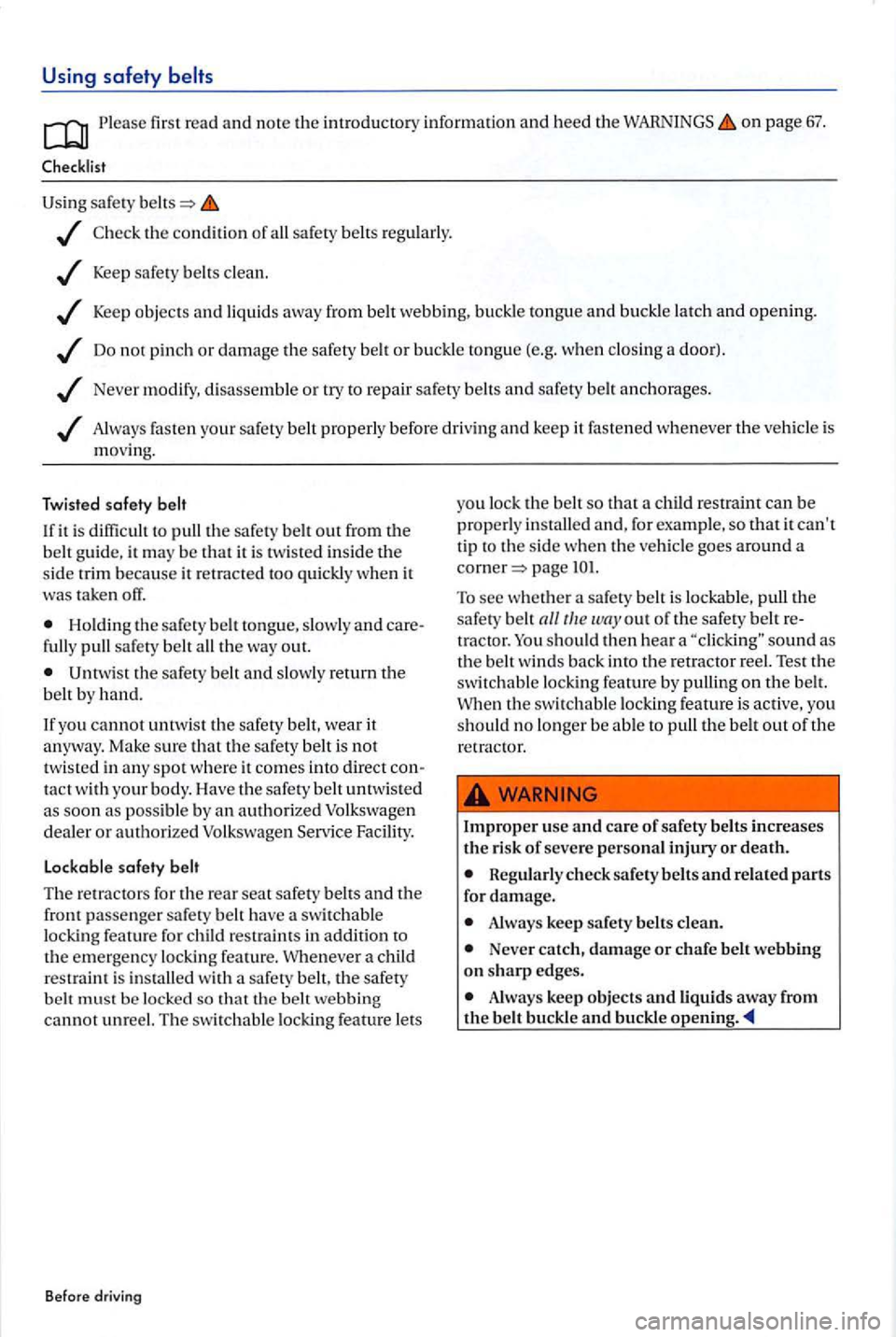
Using safety
P lease first read and note the introductory information and heed the on page 67.
the condition of all safety belts regul arly .
Keep safety belts clean .
Keep objects and liquid s away from belt webbing, buckle tongue and buckle la tch and opening .
Do not pinch or damage the safety belt or buckle tongue (e.g . w he n closing a door) .
Never modify, disassemble or try to repair safety belt s and safety belt anchorages .
Always faste n your safety belt properly before driving and keep it fastened whenever the ve hicle is moving.
Twisted safety belt
I f it is diffic ult to
pull the safety belt out from th e belt guide. it may be that it is twi sted insi de the side trim because it retracted too q ui ckly when it was take n off.
Holding the safety belt to ng ue, slowl y and fully pull safety belt all the way out.
Fa cility.
Lockable safety belt
Th e re tractors for th e rear seat safety belts and the fron t passenger safety be lt have a swit chable locking feature for child rest raints in addition to the emergency locking fea ture. a c hild
restraint is installed w ith a sa fety belt , the safety belt must be locked so that th e belt webbing cannot unreel. The switchable lockin g feature lets
Bef ore driving
you lock the belt so that a child restra int can be properly installe d and, for example, so that it can't tip to the side when the vehicl e goes around a page
To see whether a safety belt is lockable, pull the
safety belt n llrh e wnyout of the safety belt tr actor. should then hear a
th e switch able locking feature is active, you
s hould no lo nger be able to pull the belt out o f the retractor.
Improper use and care of safety belts increases th e risk of severe personal or death.
Regu larly check safety belt s and rela ted parts for damage.
A lways keep safety belts clean.
Neve r catch, damage or chafe belt webbing on sharp edges.
Always keep objects and liquids away from the belt buckle and buckle opening.
Page 74 of 541
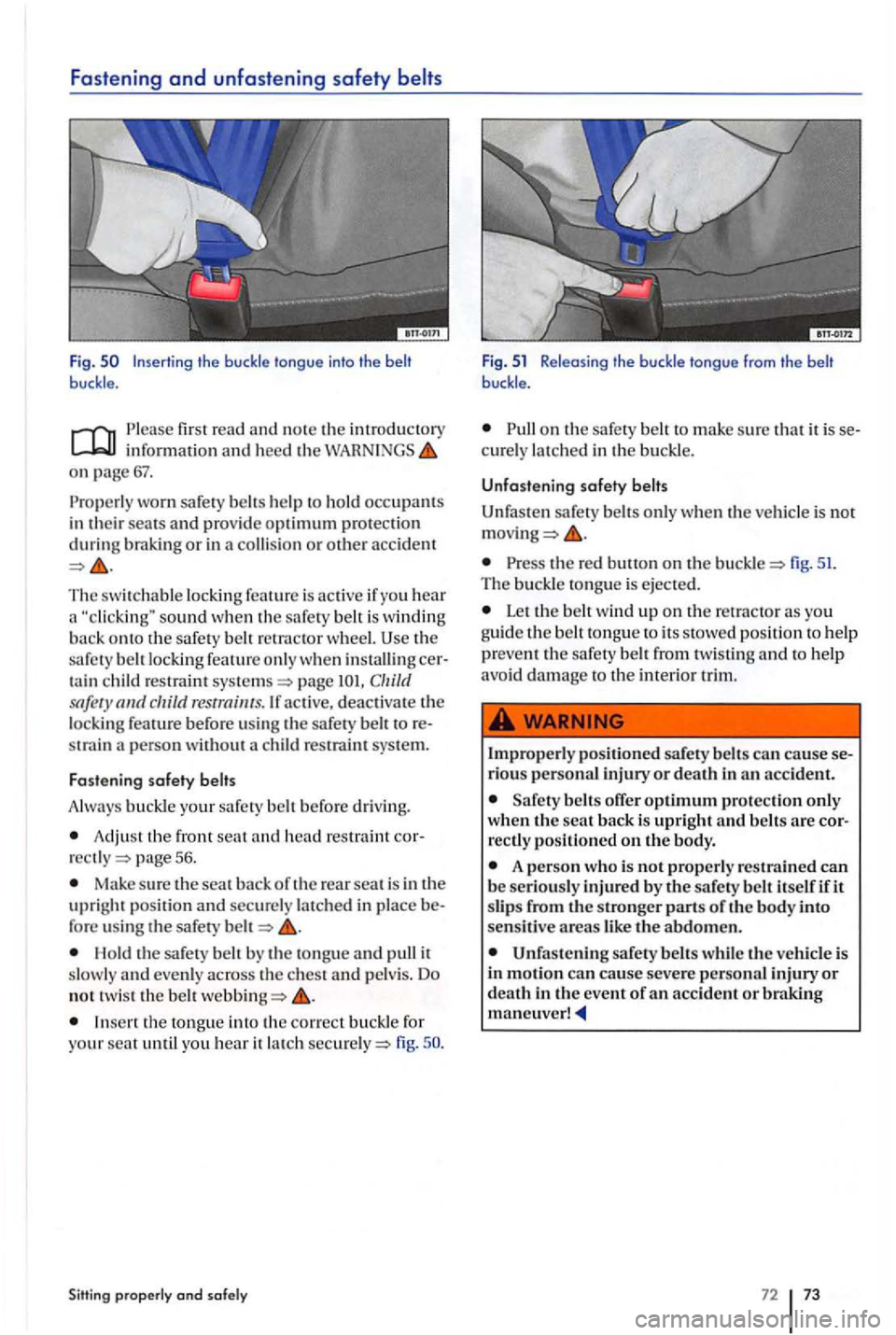
Fasten ing and unfa ste ning safety
buckle.
fir st read and note th e introductory information and heed the on page
worn safet y belts he lp to hold occupants
in their s ea ts and provid e optimum protection during braking or in a collision or othe r a ccide nt
The switchable locking feature is ac tive if you hear
a
the sa fety belt lock ing feature only whe n in sta llin g tain chil d restraint page
stra in person without a child restraint sys te m .
Fastening safety
Always buck le your safety b elt b efo re driving .
Adju st the front seat and head restraint page 56.
Make sure the seat back of th e rear seat is in the uprig ht position and secure ly la tc hed in pla ce fo re usin g the safety
Hold the sa fety belt b y th e tongue and pull it slowly and eve nly acros s th e c hest and pelv is. Do not twist th e belt
the tongue into th e correct buckle for
your seat until you hear it latch fig.
Sitting properly and safely
Fig. 51 Releasin g th e buckle tongue from the
sa fe ty belts only when th e ve hicle is not
the re d button on the fig. 51. The buckl e tongue is e jec te d.
Le t th e belt wind up on th e re tracto r a s yo u
g uid e th e belt tongue to its s to wed position to help
prev ent the safe ty belt from twisting and to help avo id d amage to the interior trim .
Improperly positioned safety belts can cause rious personal injury or death in an accident.
belt s offer optimum protection only when the seat back is upright and belts are
A person who is not properl y re strained can be seriously injured by the safe ty b elt itself if it
s lip s from the stronger parts of th e body into sensitive areas like the abdomen.
Unfastening safety belts while the vehicle is
in motion ca n cause severe personal injury or death in the event of an acc ident or
72
Page 77 of 541
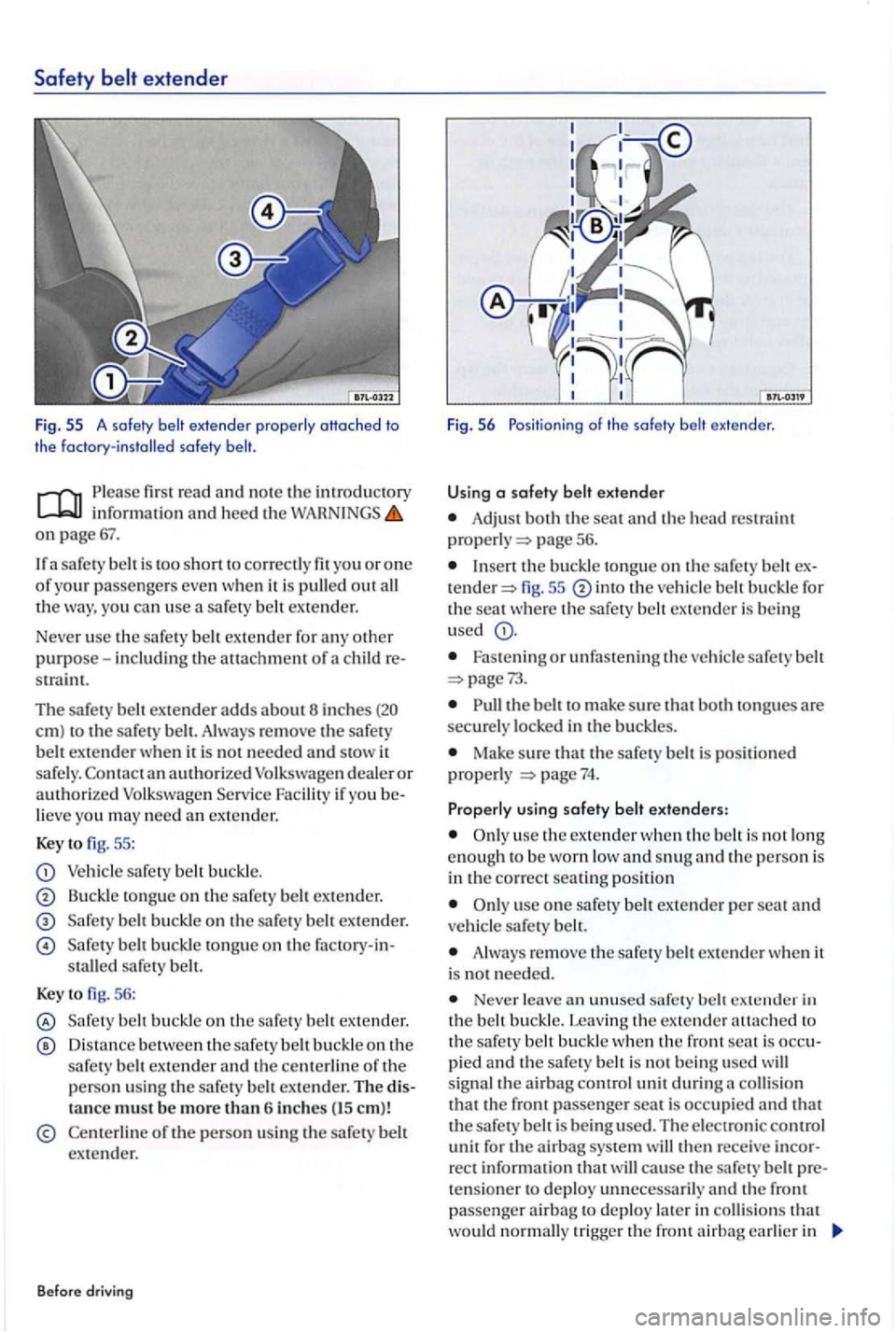
Safety extender
Fig. 55 A safety belt
fir st read and no te the in troducto ry in formatio n and heed th e on page 67.
a safet y is too shonto correctly fit you or one of your passe nge rs eve n whe n ou t th e way . yo u can use a safety ex te nder.
Never u
se the safe ty belt extender fo r any other purpose-in cludin g the of child
Th e extender adds about 8 inches em) the safe ty re move the safe ty ex te nd er w he n safe ly. an authori zed dealer or authorized if yo u you may need an extender.
Key fig. 55:
buckle.
Buck le tong ue on the safety ex tender.
b uckle o n th e safety
buckle to ngu e on the fac tory-i n-safe ty bell.
K
ey t o fig . 56 :
buckle on the safe ty belt extender.
Dista nce between th e safe ty buckle on the safe ty ex tende r and th e of the person u sin g safety belt extende r. The tance mus t b e more than 6 inches (15 em)!
ex tender.
Befor e dri ving
Fig. 56 Positionin g of th e safety ex tender.
Using a s
afety extender
Adjust b oth the seat and the head restraint page 56 .
se n the buckle to ngue on the sa fe ty fig. 55 buckle for the seat w he re the safety extender is bein g
used
Fas tening o r unfa stening the
make s u re bo th to ngues are securely locke d in the buckles.
Make sure safe ty is position ed properly 74.
u se the ex tend er w he n the
use one ex te nder p er seat and
A lway s re move th e safet y extende r w he n is no t needed .
Neve r leave an unused safe ty ex tende r in th e b uckle. Lea vin g the scat is pi ed and the sa fe ty sig nal the airb ag d urin g that the front passenge r seat is occupi ed and that the sa fe ty then r ece ive rec t inform ation that cause the safety ten sio ne r d eploy in w ould tri gge r the airba g ea rlier in
Page 81 of 541
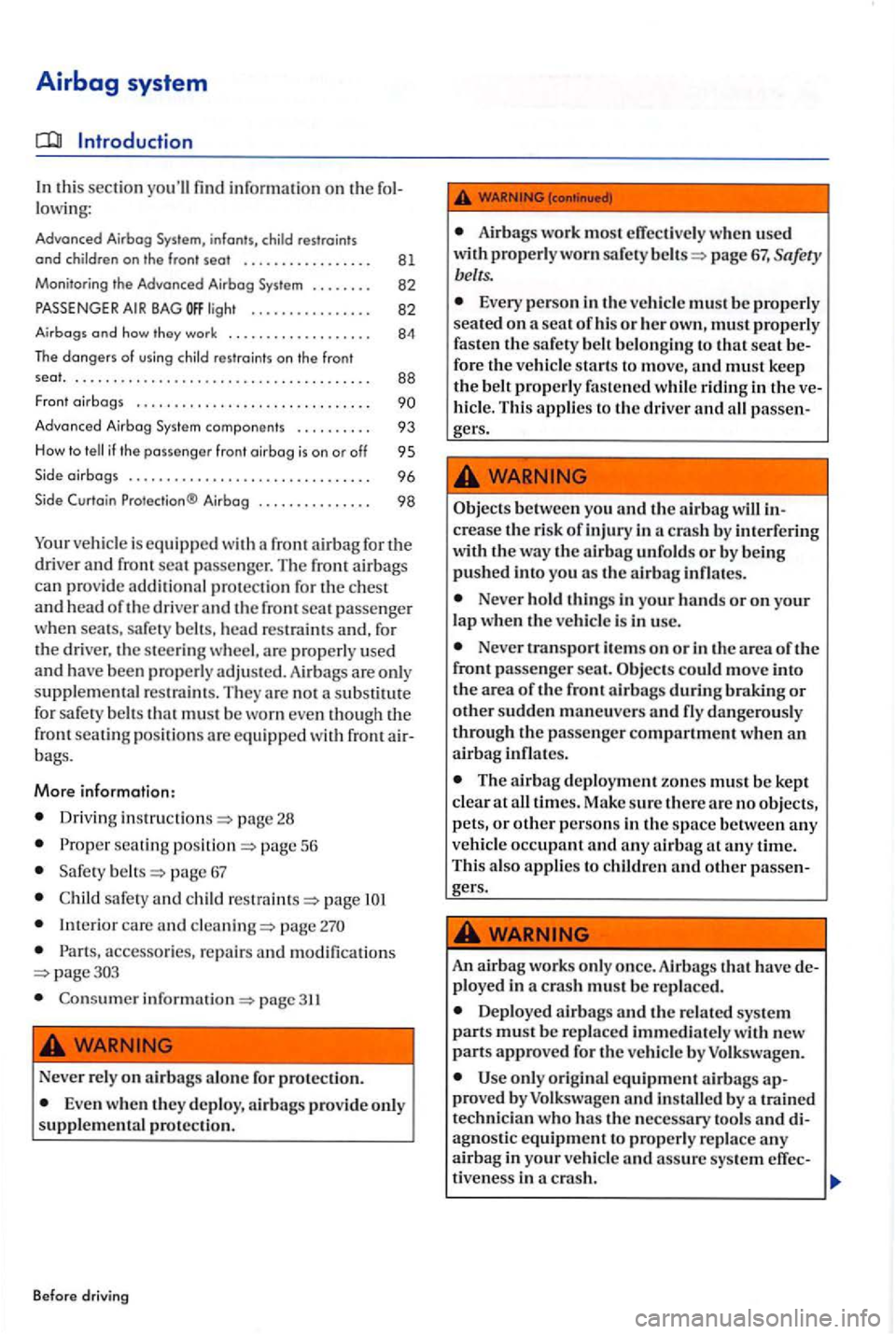
Airbag system
find information on th e fol
low ing :
Advanced Airbog
. 82
. . . . . .
Advanced Airbog Sys tem compon e nt s . . . . . . . . . . 93
H ow to if the passenger fron t oirbog is on or off 9 5
. . . . . . 98
Your vehicle is e quipped a front air bag for the
d ri ve r an d fro nt pa sse nger. The front airbag s can pro vide additional p ro tec tion fo r th e ch est and h ead of th e driver and the fro nt sea t p assenge r seats, sa fe ty belts, h ead re stra int s and, for
the driver, th e s teerin g whee l, are prop erly use d and have bee n properly adjusted. Airb ags are on ly
s u pplemental restraints. Th ey are not a su bstitut e for sa fe ty belt s th at must be wo rn eve n though front seatin g pos itions are equipp ed wit h front air
bag s.
More information:
Driv ing instru ction s=> page
seating position=> pag e 56
Safe ty belts=> page 67
sa fe ty and child pa ge
care and pag e
accessories, re pa ir s and modifica tion s pag e303
informati on=> page 311
Never rely on a irbags alone for protect io n.
Eve n when th ey deploy, airbags provide only
s uppl em ental protec tion.
Be fore driving
Airbag s work most effec tive ly w hen used
with properl y worn safe ty belt s=> page 67,
Every perso n in the ve hicl e must b e prop erl y seated on a seat of hi s or he r own, must properl y faste n th e safet y belt belongi ng to th at seat b e
for e the vehicle sta rt s to move, and must ke ep the belt properly faste n ed whil e riding in the ve
hicle. Th is a pplie s to the driv er and all
Obj ects between you an d the airbag will crease the risk of injury in a crash by interfe rin g
witl1the way the airbag unfolds or by being push ed into you as the a irbag inflates.
Never h old th ings in your hand s or on your lap when the vehicl e is in use.
Never items on or in th e area of th e
front passe nger seat. Ob jects could move into
th e a rea of the front airbag s during braking or other sudden maneu ve rs and fly dan gero usly
through the passe nge r compartment when an airbag infl ates.
The airbag deploym ent zones must be kept
clear at all tim es. Make sure there are no objects ,
pets, or ot her persons in the space be tween any ve hicl e occupant and any airb ag at an y time. Thi s also applie s to c hildr en and o ther pa sse n
gers .
WARNING-
An airb ag works o nl y once. Airbag s th a t h ave de
plo yed in a cras h must be re placed.
Deployed airbag s and the re lated sys tem
p art s must b e repla ced immediately with new parts approved for the ve hicl e by Volkswagen.
Use o nly orig inal equipment airb ags ap
prov ed by Volkswag en and by a trained
techni cian who has the necessary too ls and di
agnostic eq uipmen t to properl y replace an y airbag in your ve hi cle and assure sys te m effec-
ti veness in a c rash.
Page 82 of 541
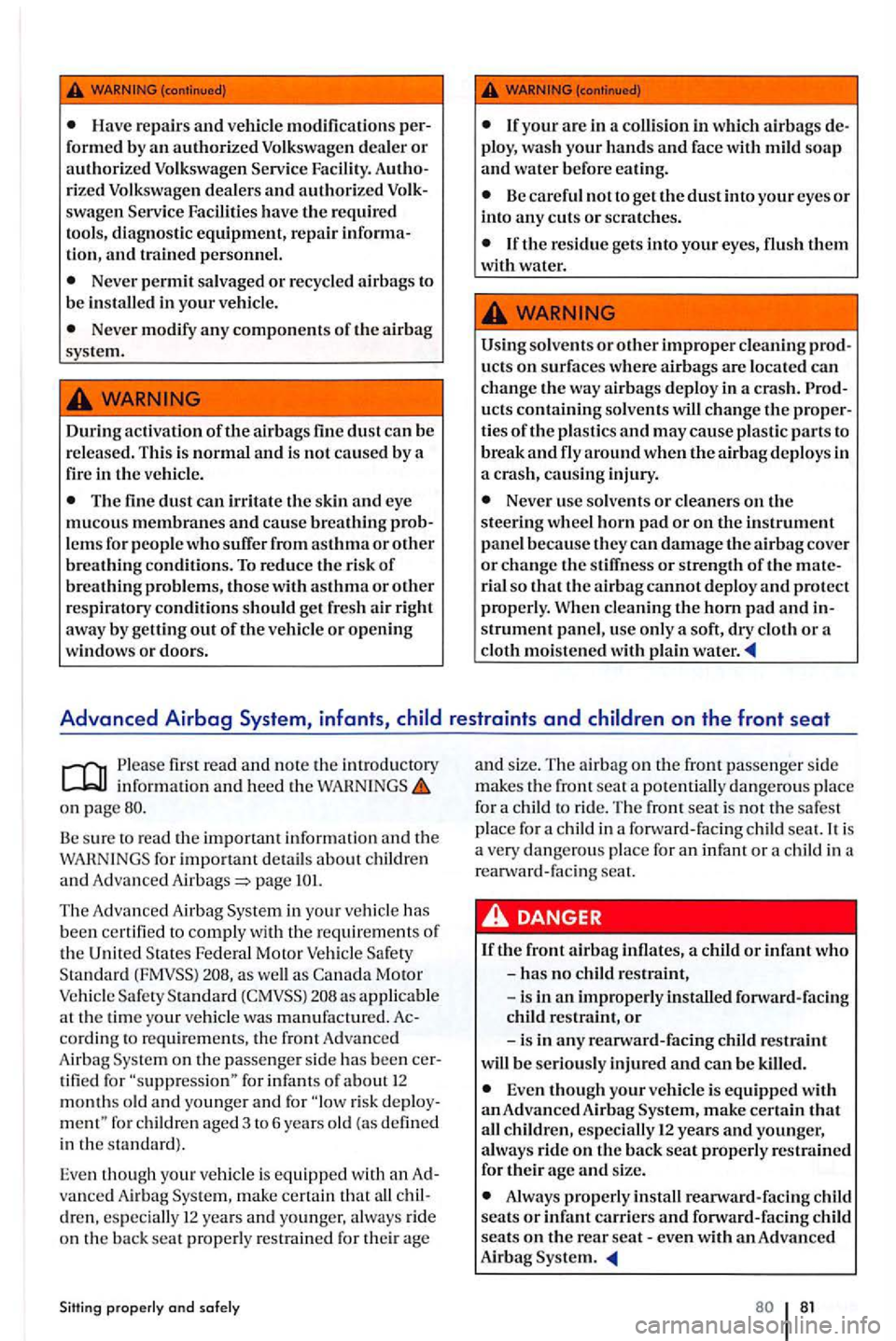
Have repairs and vehicle modification s
rized Volkswagen dealers and authorized swagen Facilities have the required
tool s, dia gnostic equipment, repair tion, and trained personnel.
Never permit salvaged or recycled airbags to be installed in your veh icle.
Never modify any components of the airbag syste m.
During activation of the
The fine dust can irritate the skin and eye muco us membranes and cause breathing lems for people who suffer from asthma or other breathin g conditions. To reduce th e risk of breathing probl em s, those with asthma o r o th er
r es piratory
Be careful no t t o ge t the dust into your eyes or
into any c uts or sc ratches.
Using so lve nts or other improper cleaning
u cts containing so lvents w ill ch ange the ti es of the plastic s and may cause plastic parts to break and fly around when the airbag deploys in a crash, causin g injury.
Never usc so lven ts or cleaners on th e
s teering wheel horn pad or on the instrument pan el b eca use they ca n damage the airbag cover or change the s tiffness or strength of the rial so that the airba g cannot deploy and protect properly. When cleaning the horn pad a n d strument panel, use onl y a soft, dry cloth or a
cloth moistened w ith plain water.
Please first read and note th e introductory informatio n and heed the WARN INGS on
Be sure to read the important inform ation and th e for important detail s about child ren
and Adva nce d Airbags
in you r ve hicl e has
been ce rtifi ed to comply wit h th e requirement s of the Unit ed Federal Moto r Vehicle as well a s Motor Vehicl e as a pplicabl e
at the time your vehicle was manufactured. co rding to req uirement s, th e front Advance d
A ir bag on th e passeng er side h as been tified for for infant s of about 12
months old and you nger and for risk for ch ildren aged 3 to 6 yea rs old {as defined
in the stand ard ).
Even th ough your vehicl e is equipp ed w ith an vance d Air bag mak e ce rtain that all dre n, es pecially 12 years and younge r, a lways ride
o n th e back seat properly restra ined for their a ge
Sitting properly and safely
and size. The airb ag on the front passenge r side m ak es the fron t seat a potentially dangerou s pla ce for a child ride. Th e front seat is no t th e sa fest
p lace for a child in a fo rward -faci ng chil d seat. is
a very dangerous place for an in fant or a child in a
r earward-fac ing sea t.
is in an improp erl y in stall ed for ward-faci ng
child res traint, or
in an y rearward- facing child restraint
will
be se riously injur ed and can be kill ed.
Eve n though your vehicl e is equipped with an Advance d Air bag make certain that aU children, especia lly years and you nger,
a lwa ys rid e o n the back seat properly restrained
for their age and s ize.
Always properly install reanvard-facing child seats or infant carriers and forward -faci ng c hild
s eats on the rear seat-even with an Advanced
81
Page 87 of 541
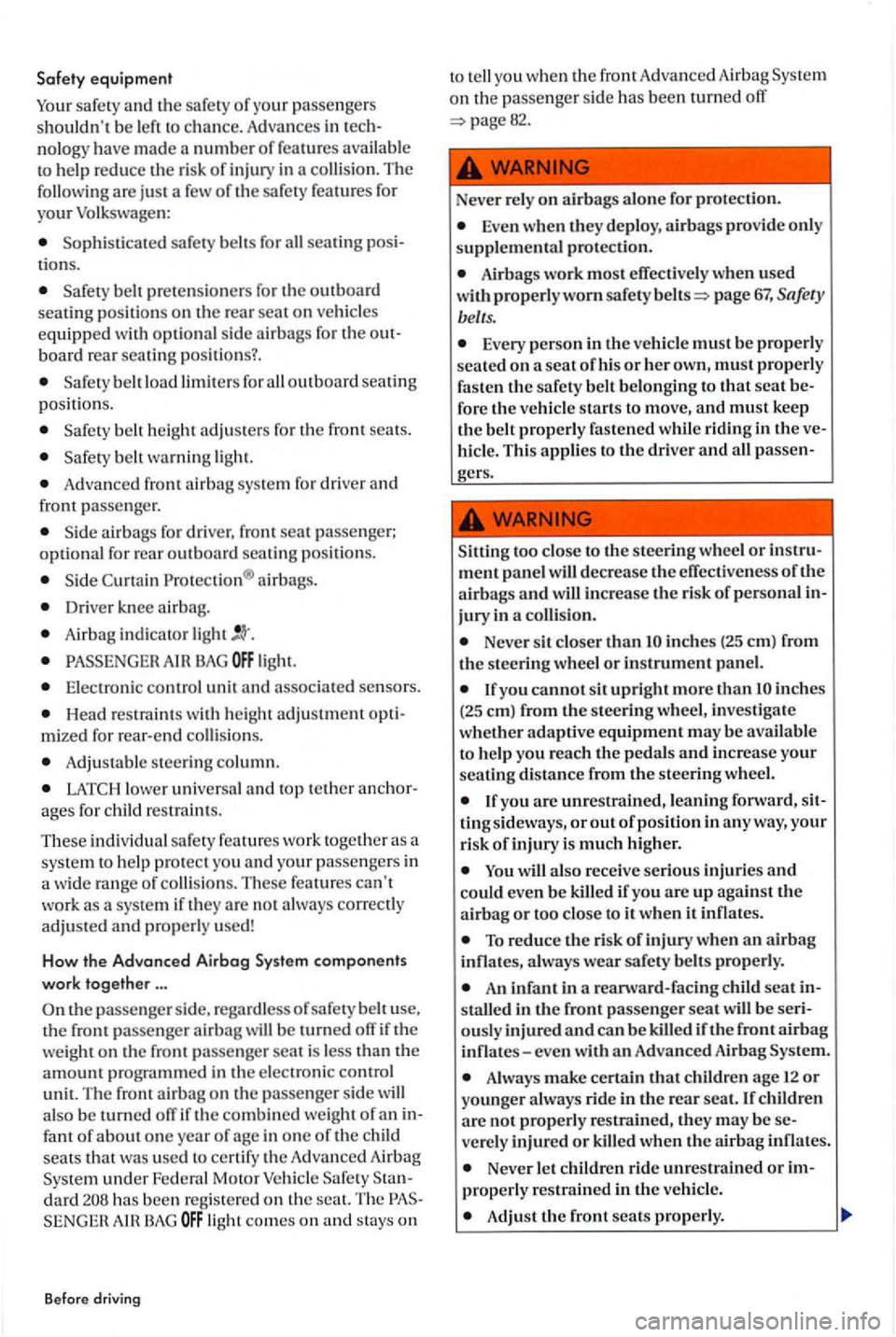
Safety equipment
safet y and the s afe ty of your p assenge rs shouldn 't be l eft to c han ce. Advances in tech
nolo gy have made a numb er of featur es available help reduce the ris k of injury in a collisio n. The follo wi ng are just a few o f th e sa fe ty features for your Volkswag en :
Soph is ticated safety belts for all seating posi
tions.
Safety belt pretensio ne rs for the outboard seatin g positi ons on the rea r seat o n ve hicl es equipped with optional side a irbags for the o ut
board rear seating positi ons?.
belt load limit ers fo r all outb oa rd seating
positions.
b elt h e ig ht adju ste rs for the front
belt warning light.
A dvanced front airba g sys tem for driver and fro nt passe nger.
airbag s.
Driver knee airbag .
Airbag indicator light
BAG light.
Ele ctronic cont rol unit and asso ciat ed senso rs.
Head res traint s w ith heig ht adju stment opt imized for rear -end collisio ns.
Adju stabl e stee rin g column.
lo w er univer sa l and top te th er an chor
age s for child restraint s.
These individual safety wo rk tog eth er as sys te m t o help pro tect yo u and your passenger s in w id e rang e of collisio ns. Th ese features can't
work as a syste m if they are no t a lwa ys correctly
adju ste d and prope rly used!
How the Advanced Airbag System components
work together ...
in
fan t of about one yea r o f ag e in one of th e c hild
seats u sed to certif y th e Adva nced Airb ag under Federa l Motor dard h as been regis te re d on th e seat. Th e AI sta ys on
Before driv ing
o n th e passenge r side has been turned off
Neve r rely on airbags alone for protec tion.
Even wh en they depl oy, airbags provide only
supplemental protection.
Airbag s work most effec tive ly when used with properly worn safe ty page 67, Safety
belt
s.
Every person in ve hicle must be prope rl y
se ated on a seal of his or he r own, must prope rl y
fasten the s afety belt belonging to that seat be
fore th e ve hicle start s to move, and must keep the belt properly fas tened w hil e riding in the ve
hicle. This applies to the dri ver and all passen-
too close to the steering wheel or instru
m ent panel will dec rease the effectiveness of th e
airbags and will increase the risk of personal in
jury in a coUision .
Never sit closer than inche s (25 em ) from the s teering whee l or instrument panel.
If yo u cannot sit upright more th an inch es (25 em) from the steering wheel, investigat e
whether adaptive equipment may be ava ilable
to help you reach the pedal s and increase your seating di stance from the steering wheel.
If you are unres trained , leaning fonvard, sit
tingsideway s, or out of position in anyway, your ris k of injury is m uch higher.
To reduce the risk of injury w hen an airbag always wear safety belt s properl y.
A n infant in a reanvard-facing child seat in
s talled in the front passe nge r seat w ill be seri
ously injured an d ca n b e killed if the front airbag
inflates-even with an Advanced Airbag
Always make certai n that children age 12 or younger alway s ride in the re ar seat. If childre n
are not properl y re stra in ed, they may be se
ve rel y injured or killed when th e infl ates.
Never le t children ride unres trained or im properly re strain ed in th e ve hicl e.
Adjust the front seats properly.